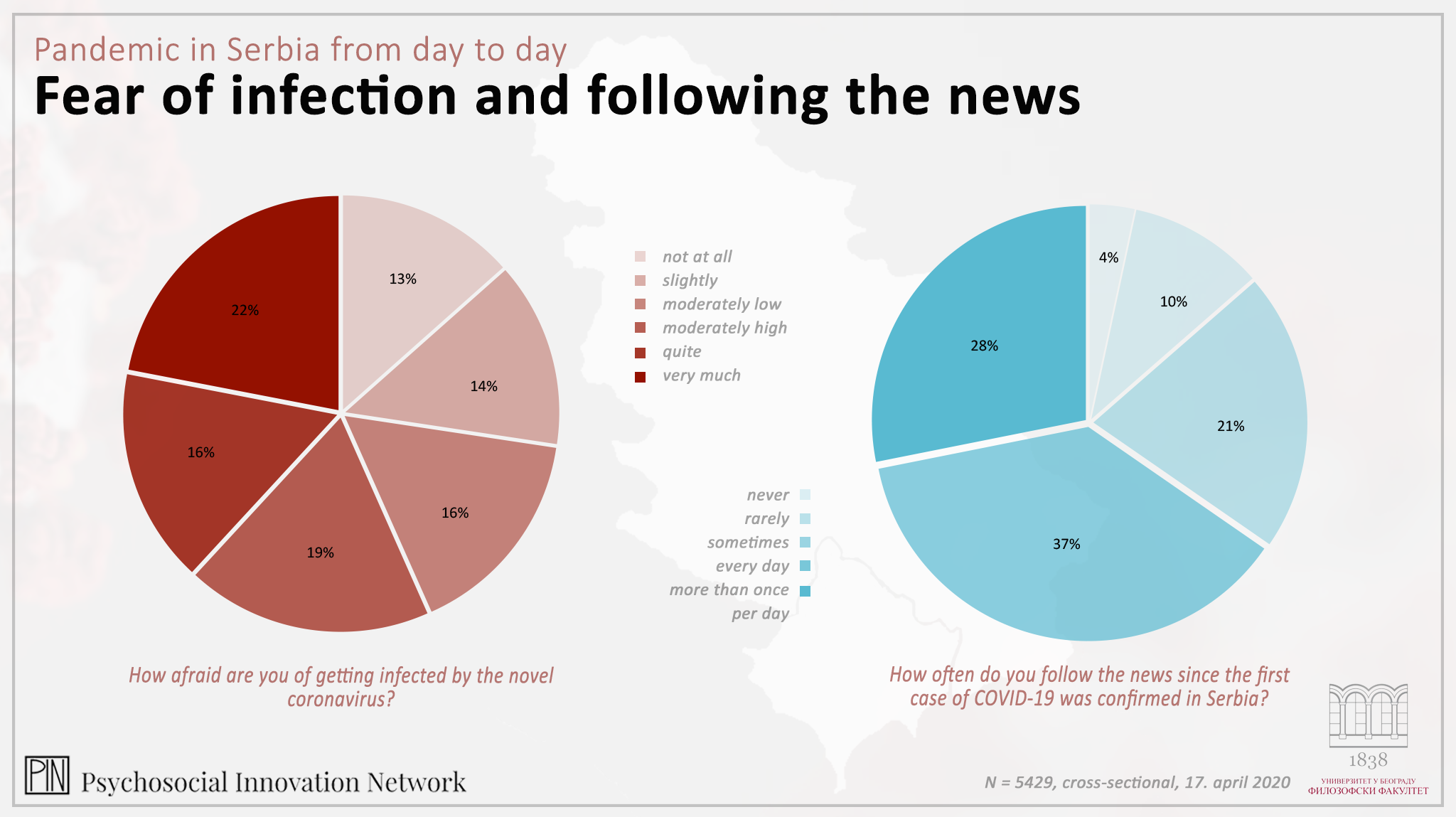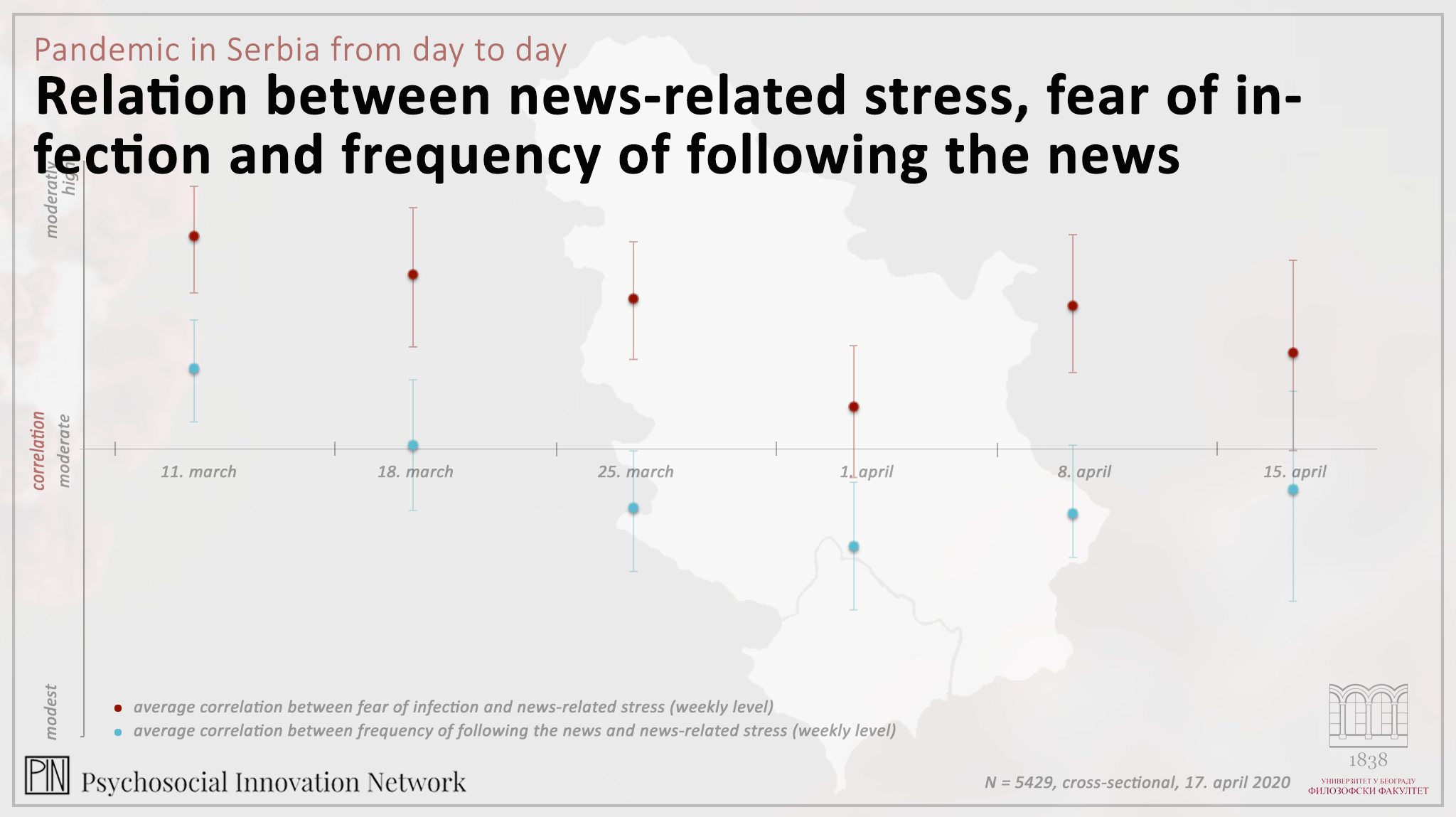
When the first case of coronavirus infection was confirmed in our country, the entire society, as well as all aspects of our lives, all of sudden had to adapt to the new circumstances. During these early days there were so many things we had to master and learn, we had to organize and inform ourselves and at the same time take care of ourselves and people that depended on us. But in order to do all of this in such a short period of time, we also had to find a way to put our fears and worries aside. We needed time to “land on our feet”, emotionally speaking, and calm down after the first shock.
Our worries and fears changed over the last month and a half, because the circumstances we found ourselves in changed, as well. For that reason today’s article will focus on changes in feelings of fear and worry. We asked you how worried you were about the coronavirus, how serious did you consider the situation to be and were you afraid of getting infected. Apart from this, the pandemic itself brings a lot of uncertainties with it: what will become of the world, in general, how long will the state of emergency last, who will be the most affected, when will all this end, and all of these are the things we have very little control of. That was why we also asked you to how do you estimate and how did you estimate the possibility of limiting the spread of infection before the pandemic and how helpless do you feel regarding this situation.
What the results say?
Who Is Afraid and How Much?
We are all afraid, every day – only 13% of the participants in our study said that they are not at all afraid of getting infected by coronavirus, while more than a half of participants said they are very afraid (moderately to very afraid). So, a vast majority of us is afraid of the infection, which is a normal consequence of the situation in which the important elements of our lives, such as health, livelihood and social support are potentially threatened.
News
One of the ways in which we try to influence our emotions, i.e. reduce our fear and worry, is to inform ourselves about the situation and to understand it. This is the reason why we follow news on pandemic on daily basis – 4% of participants said they don’t follow the news at all, while two thirds inform themselves on daily basis or several times a day. It becomes especially important to follow the news in isolation and self-isolation, when other public spaces and social exchanges are not available – when news actually become the only “window to the world”. Besides that, there is just a few news that are not about coronavirus, which is expected, since this is the type of situation that permeates all aspects of the society.
What Scares Us, What Calms Us Down and How Is Following the News Related to That?
We can see on the graph that over a certain time period we tracked the fear of getting infected by coronavirus (red line) and how often we followed news on coronavirus (blue line). The frequency of following the news on coronavirus hasn’t changed a lot over the previous 40 days, but the fear of getting infected by coronavirus varied from moderate to high. In the first twelve days from the moment first case of infection has been registered in our country, the fear grew steadily. However, it started to decline when curfew was imposed and then extended (17 and 22 March, respectively), which can be related to the impression that the way to overcome the situation is actually being sought. It is particularly important that the study showed that the fear is not only connected with the introduction of measures by itself, but that the announcement of measures that were never introduced and the manner of communication with the citizens was also related to sudden increase of fear among people. Namely, results of the study show that fear among people of Serbia suddenly increased after the message sent on 31 March that we were getting very close to Italian and Spanish scenario, as well as when it was announced that 24-hour curfew would be introduced. This shows how important taking care of communication strategy during pandemic and state of emergency is, and the extent to which it is important not to take lightly a decision about what messages and in which manner will be publicly communicated by the authorities, considering that the data from our study shows that it is connected to and may affect psychological condition of citizens which are already exposed to significant amount of stress and challenges.
Worry and fear are higher today than they were before pandemics, but they are still lower than they have been at peak points of the previous period, such as 17, 21 and from 24 to 28 March. The results show that we managed to find the way to adapt to the situation to a certain extent in order to get through it. However, although we are no longer in the state of the highest agitation, we are still living under pressure, so, after the immediate danger passes, certain people may suffer a postponed emotional reaction, but other mental difficulties, as well. If possible and if circumstances allow us, it would be best now not to bother ourselves any further, because, when it all passes, it is natural to expect that some people will have a strong sense of mental fatigue.
This is actually the reason why professionals are more and more often sending a message that it is very important to preserve the mental health during the pandemic. Results of the study also show that despite the challenging situation in which we have all found ourselves in, it seems that we still find the ways to function. We find spontaneous ways to calm down (everyone has its own way and some ways require understanding and tolerance), which is a self-regulatory psychological mechanism – better known in psychology as resilience or ability not to fall apart in challenging situations (more on that in one of the future articles).
For Those Who Want to Know More
Informing ourselves due to stress
Although the need to stay informed is normal, especially in uncertain situations, the news we listen to in these circumstances are almost always bad and speak about the number of infected and deceased people, the number of infected healthcare workers, equipment required for treatment, which is often short supply, etc. So, on one hand, we try to stay informed to calm down and “stay updated”, while on the other hand, this is exactly the type of things that can upset us further. This is why we studied the connection between stress caused by following the news, on one hand, and fear of getting infected by coronavirus and frequency of following the news, on the other hand. As the situation changed (e.g. new hotspots, opening of new hospitals, introduction of different isolation measures) our feelings, level of awareness, anxiety caused by awareness, as well as the relationship between all these factors changed, as well.
 From the first survey until today, the more stressful following the news on coronavirus became, the higher our fear of getting infected by coronavirus got. However, the connection was at the lowest level in the fourth week. Conversely, the more stressed we got from following the news on coronavirus, less we followed such news. The connections between the stress caused by information, the frequency of getting information and the fear of getting infected show that when we inform ourselves, we don’t do that just to gather data, but the process of getting informed itself has a role in emotional regulation, as well. This is one more reason why getting timely and reliable information is particularly important when we face such social challenges.
From the first survey until today, the more stressful following the news on coronavirus became, the higher our fear of getting infected by coronavirus got. However, the connection was at the lowest level in the fourth week. Conversely, the more stressed we got from following the news on coronavirus, less we followed such news. The connections between the stress caused by information, the frequency of getting information and the fear of getting infected show that when we inform ourselves, we don’t do that just to gather data, but the process of getting informed itself has a role in emotional regulation, as well. This is one more reason why getting timely and reliable information is particularly important when we face such social challenges.

 Graph 1
Graph 1